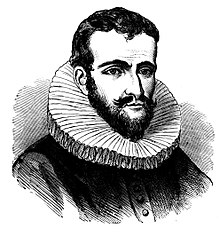Henry Hudson | |
|---|---|
 One of many speculative portraits[a] | |
| Born | c. 1565 |
| Disappeared | 23 June 1611 (aged 45–46) James Bay, North America |
| Other names | Hendrick Hudson (in Dutch) |
| Occupation(s) | Sea explorer, navigator |
| Years active | 1607–1611 (as explorer) |
| Employers | |
| Known for |
|
| Children | John Hudson (c. 1591–1611) |
Henry Hudson (c. 1565 – disappeared 23 June 1611) was an English sea explorer and navigator during the early 17th century, best known for his explorations of present-day Canada and parts of the Northeastern United States.
In 1607 and 1608, Hudson made two attempts on behalf of English merchants to find a rumoured Northeast Passage to Cathay via a route above the Arctic Circle. In 1609, he landed in North America on behalf of the Dutch East India Company and explored the region around the modern New York metropolitan area. Looking for a Northwest Passage to Asia[3] on his ship Halve Maen ("Half Moon"),[4] he sailed up the Hudson River, which was later named after him, and thereby laid the foundation for Dutch colonization of the region. His contributions to the exploration of the New World were significant and lasting. His voyages helped to establish European contact with the native peoples of North America and contributed to the development of trade and commerce.
On his final expedition, while still searching for the Northwest Passage, Hudson became the first European to see Hudson Strait and the immense Hudson Bay.[5] In 1611, after wintering on the shore of James Bay, Hudson wanted to press on to the west, but most of his crew mutinied. The mutineers cast Hudson, his son, and six others adrift; what then happened to the Hudsons and their companions is unknown.[6]
- ^ Butts 2009, p. 17.
- ^ Hunter, D. (2007). God's Mercies: rivalry, betrayal and the dream of discovery. Toronto: Doubleday. p. 12. ISBN 978-0385660587.
- ^ De Laet, J. (1625). Nieuvve wereldt, ofte, Beschrijvinghe van West-Indien (in Dutch). Leyden: Elzevier. p. 83. OCLC 65327738.
- ^ "Half Moon :: New Netherland Institute". www.newnetherlandinstitute.org. Retrieved 23 April 2024.
- ^ Rink, O. A. (1986). Holland on the Hudson: an economic and social history of Dutch New York. Ithaca: Cornell University Press. p. 29. ISBN 978-0801418662.
- ^ "Biography – Hudson, Henry – Volume I (1000–1700) – Dictionary of Canadian Biography". www.biographi.ca. Retrieved 24 May 2023.
Cite error: There are <ref group=lower-alpha> tags or {{efn}} templates on this page, but the references will not show without a {{reflist|group=lower-alpha}} template or {{notelist}} template (see the help page).